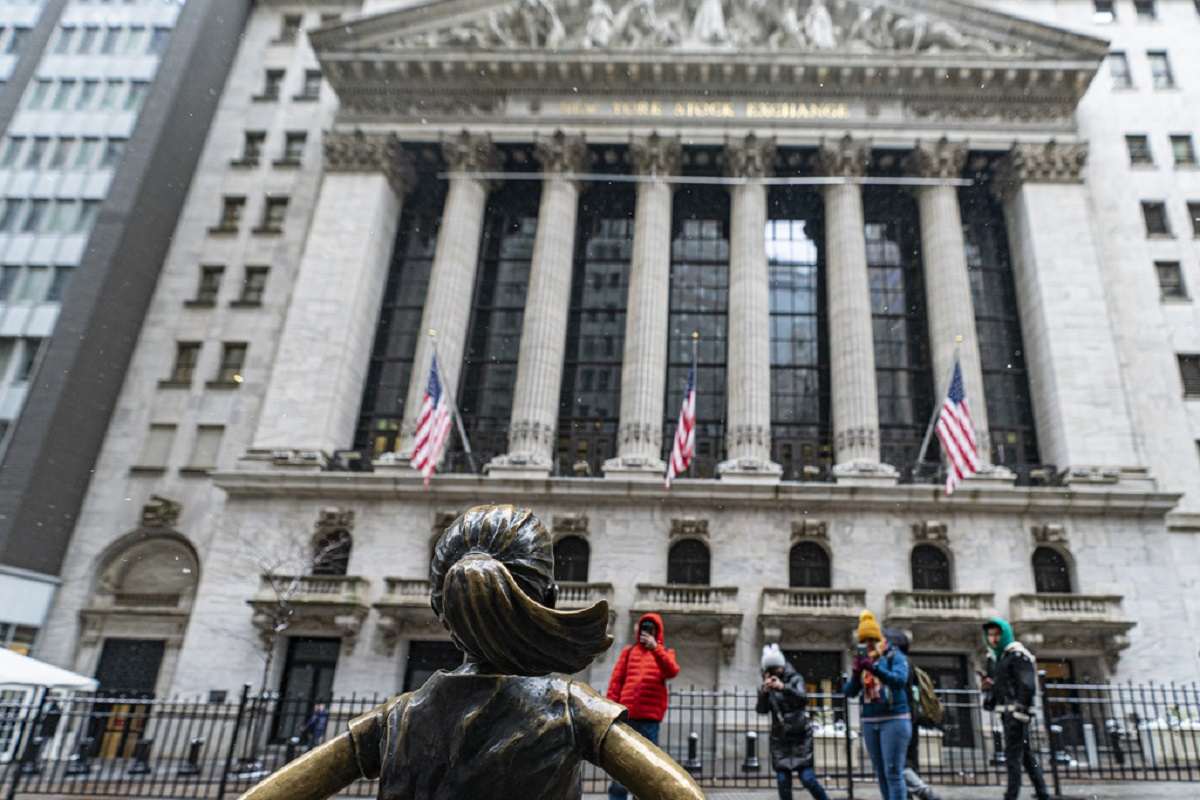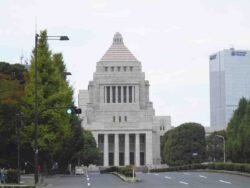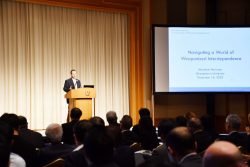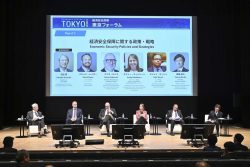
The Fearless Girl statue stands outside of the New York Stock Exchange is shown on Friday in New York.
13:05 JST, January 20, 2024
NEW YORK (AP) — Wall Street returned to record heights Friday to cap a punishing, two-year round trip dogged by high inflation and worries about a recession that seemed inevitable but hasn’t arrived.
The S&P 500, which is the centerpiece of many 401(k) accounts and the main measure that professional investors use to gauge Wall Street’s health, rallied 1.2% to 4,839.81. It erased the last of its losses since setting its prior record of 4,796.56 at the start of 2022. During that time, it dropped as much as 25% as inflation soared to levels unseen since Thelonious Monk and Ingrid Bergman were still alive in 1981.
Even more than high inflation itself, Wall Street’s fear was focused on the medicine the Federal Reserve traditionally uses to treat it. That’s high interest rates, which press the brakes on the economy by making borrowing more expensive and hurting prices for stocks and other investments. And the Fed rapidly hiked its main interest rate from virtually zero to its highest level since 2001, in a range between 5.25% and 5.50%.
Historically, the Fed has helped induce recessions through such increases to interest rates. Coming into last year, the widespread expectation on Wall Street was that it would happen again.
But this time was different, or at least it has been so far. The economy is still growing, the unemployment rate remains remarkably low and optimism is on the upswing among U.S. households.
“I don’t think this cycle is normal at all,” said Niladri “Neel” Mukherjee, chief investment officer of TIAA’s Wealth Management team. “It’s unique, and the pandemic introduced that element of uniqueness.”
After shooting higher as snarled supply chains caused shortages because of COVID-19 shutdowns, inflation has been cooling since its peak two summers ago. It’s eased so much that Wall Street’s biggest question now is when the Federal Reserve will begin moving interest rates lower.
Such cuts to rates can act like steroids for financial markets, while releasing pressure that’s built up on the economy and the financial system.
Treasury yields have already relaxed significantly on expectations for rate cuts, and that helped the stock market’s rally accelerate sharply in November. The yield on the 10-year Treasury slipped Friday to 4.13%, and it’s down sharply from the 5% that it reached in October, which was its highest level since 2007.
Of course, some critics say Wall Street has gotten ahead of itself, again, in predicting how soon the Federal Reserve may begin cutting interest rates.
“The market is addicted to rate cuts,” said Rich Weiss, chief investment officer of multi-asset strategies at American Century Investments. “They just can’t get enough of it and are myopically focused on it.”
Repeatedly since the Fed began this rate-hiking campaign early in 2022, traders have been quick to forecast an approaching easing of rates, only to be disappointed as high inflation proved to be more stubborn than expected. If that happens again, the big moves higher for stocks and lower for bond yields may need to revert.
This time around, though, the Fed itself has hinted that rate cuts are coming, though some officials have indicated they may begin later than the market is hoping for. Traders are betting on a nearly coin flip’s chance that the Fed will start cutting in March, according to data from CME Group.
“The truth is likely somewhere between what the Fed is saying and what the market is expecting,” said Brian Jacobsen, chief economist at Annex Wealth Management. “That will continue to cause dips and rips” for financial markets “until the two reconcile with each other.”
Some encouraging data came Friday after a preliminary report from the University of Michigan suggested the mood among U.S. consumers is roaring higher. It said sentiment jumped to its highest level since July 2021. That’s important because spending by consumers is the main driver of the economy.
Perhaps more importantly for the Fed, expectations for upcoming inflation among households also seem to be anchored. A big worry has been that such expectations could take off and trigger a vicious cycle that keeps inflation high.
Friday’s lift for Wall Street came with a big boost from technology stocks, something that’s become typical in its run higher.
Several chip companies rose for a second straight day after heavyweight chipmaker Taiwan Semiconductor Manufacturing Co. delivered a better forecast for revenue this year than analysts expected. Broadcom rose 5.9%, and Texas Instruments climbed 4%.
All told, the S&P 500 rose 58.87 points to its record. The Dow Jones Industrial Average set its own record a month earlier, and it gained 395.19, or 1.1%, Friday to 37,863.80. The Nasdaq composite jumped 255.32, or 1.7%, to 15,310.97.
Last year, a select few Big Tech companies were responsible for the wide majority of the S&P 500’s gains. Seven of them accounted for 62% of the index’s total return, according to S&P Dow Jones Indices.
Many of those stocks — Microsoft, Apple, Alphabet, Nvidia, Amazon, Meta Platforms and Tesla — rode a furor in the market around technology related to artificial intelligence. The hope is AI will lead to a boom in profits, both for companies using it and for companies providing the hardware for it.
Investors may have wished they had stayed in just those stocks, which got the nickname of “the Magnificent 7.” But some of them remain below their record highs, such as Tesla. It’s still down 48% from its all-time high set in November 2021.
Friday’s return of the S&P 500 to a record serves as another example that investors who stay patient and spread their investments across the U.S. stock market end up making back all their losses. Sometimes it can take a long time, like the lost decade of 2000 through 2009 when the S&P 500 tumbled through the dot-com bubble bust and the global financial crisis. But the market has historically made investors whole again, given enough time.
Including dividends, investors with S&P 500 index funds already returned to break-even a month ago.
Of course, risks still remain for investors. Besides uncertainty about when the Fed will begin cutting interest rates, it’s also still not a sure thing that the economy will avoid a recession.
Hikes to interest rates take a notoriously long time to make their way fully through the system, and they can cause things to break in unexpected places within the financial system.
"News Services" POPULAR ARTICLE
-

American Playwright Jeremy O. Harris Arrested in Japan on Alleged Drug Smuggling
-

Taiwan President Shows Support for Japan in China Dispute with Sushi Lunch
-

Japan’s Nikkei Stock Average as JGB Yields, Yen Rise on Rate-Hike Bets
-

Japan’s Nikkei Stock Average Licks Wounds after Selloff Sparked by BOJ Hike Bets (UPDATE 1)
-

Japanese Bond Yields Zoom, Stocks Slide as Rate Hike Looms
JN ACCESS RANKING
-

Japan’s Hopes for Seafood Exports Shot Down in China Spat
-

Keidanren Chairman Yoshinobu Tsutsui Visits Kashiwazaki-Kariwa Nuclear Power Plant; Inspects New Emergency Safety System
-

Japan to Charge Foreigners More for Residence Permits, Looking to Align with Western Countries
-

Japan Exports Rise in October as Slump in U.S. Sales Eases
-

Govt Aims to Expand NISA Program Lineup, Abolish Age Restriction



























